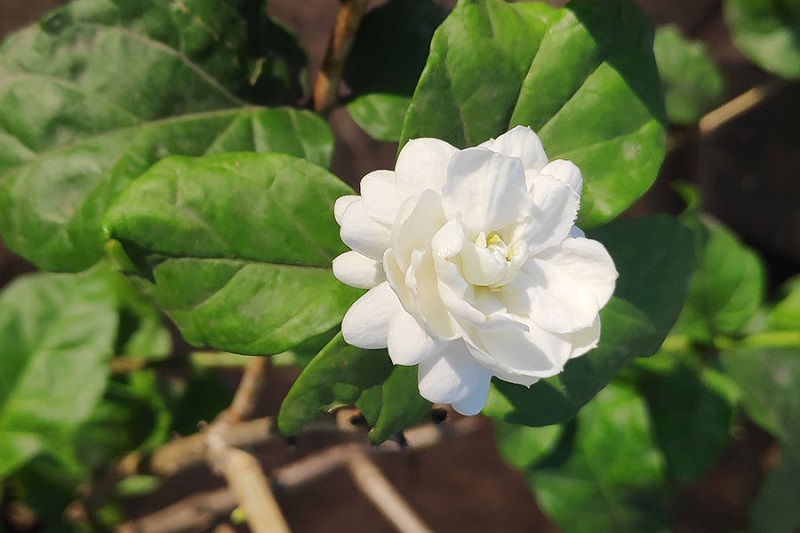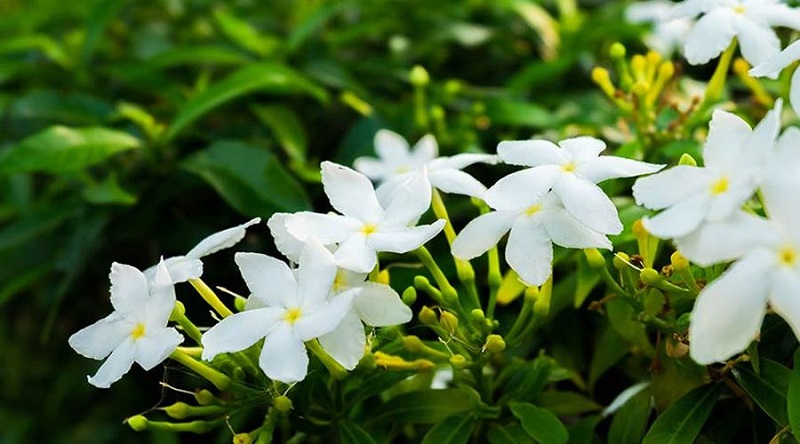Jasminum sambac, commonly known as Arabian Jasmine, is renowned for its captivating beauty and enchanting fragrance. This evergreen shrub, native to Southeast Asia, has been cherished for centuries in gardens and cultural practices. Its delicate white flowers and lush foliage make it a popular choice for gardeners and horticulturists alike. This comprehensive guide delves into the botanical characteristics, cultivation requirements, and multifaceted uses of Jasminum sambac, offering valuable insights for both seasoned gardeners and enthusiasts.
Botanical Characteristics
Plant Description
Jasminum sambac is a versatile plant that can be grown as a shrub or small tree. It is known for its climbing or trailing habit, making it suitable for various garden designs. Typically, it reaches a height of 3 to 6 feet (0.9 to 1.8 meters) and has a compact, dense form. The plant’s growth rate is moderate, resulting in a lush, green appearance throughout the year.

Leaves
The leaves of Jasminum sambac are simple, ovate to lanceolate, and arranged alternately on the stems. They are characterized by their glossy, dark green color and smooth texture, contributing to the plant’s overall aesthetic appeal. The foliage provides a vibrant backdrop to the plant’s striking flowers.
Flowers
One of the most alluring features of Jasminum sambac is its white, star-shaped flowers, which typically have five to nine petals arranged in a radial pattern. The fragrance of these flowers is sweet and intense, making them highly sought after in perfumery and aromatherapy. The blooms appear in clusters and are renowned for their ability to fill the air with their delightful scent.
Fruit and Seeds
Jasminum sambac produces small, dark berries that contain seeds. These fruits are less prominent compared to the plant’s flowers but play a role in the plant’s reproductive cycle. The seeds can be collected and used for propagation.
Cultivation and Care
Soil Requirements
For optimal growth, Jasminum sambac requires well-draining, loamy soil with a slightly acidic to neutral pH. The plant prefers rich, moist soil but should not be waterlogged. Adequate drainage is crucial to prevent root rot and ensure healthy development.
Light and Temperature
Jasminum sambac thrives in full sun to partial shade. It is adaptable to a range of temperatures but grows best in mild to warm climates. While some varieties can tolerate light frost, most require protection from freezing temperatures to maintain their health.
Watering and Fertilization
Regular watering is essential, particularly during dry periods. The soil should be kept consistently moist but not overly saturated. A balanced, all-purpose fertilizer applied during the growing season promotes robust growth and abundant flowering.
Pruning and Training
Pruning is necessary to maintain the shape of Jasminum sambac and encourage new growth. For climbing varieties, regular pruning helps manage their spread and enhances flowering. Shrubby forms benefit from occasional trimming to maintain their form and remove spent flowers. Training on trellises or supports can enhance the plant’s growth habit and aesthetic appeal.
Pest and Disease Management
Jasminum sambac can be susceptible to pests such as aphids, spider mites, and whiteflies. Common diseases include fungal infections like powdery mildew and root rot. Regular inspection and timely intervention with appropriate treatments help manage these issues effectively and maintain plant health.
Propagation
Methods of Propagation
Jasminum sambac can be propagated through cuttings or seeds. Cuttings are the most common method, involving taking stem cuttings and rooting them in a suitable medium. Seed propagation is less common but involves germinating seeds under controlled conditions.
Timing and Conditions
Propagation is best carried out during the growing season, typically in spring or early summer. Optimal conditions for rooting include warm temperatures, high humidity, and well-draining soil.

Uses and Applications
Ornamental Use
In gardens, Jasminum sambac is often used as a climbing plant on trellises, arbors, or fences. Its aromatic flowers make it a popular choice for creating scented garden spaces. The plant’s versatility also allows it to be grown in containers, making it suitable for patios and indoor spaces.
Cultural Significance
Jasminum sambac holds cultural significance in many regions. It is used in traditional medicine and is often featured in festivals and ceremonies. In various cultures, the plant symbolizes beauty, grace, and purity.
Commercial Uses
The oil extracted from Jasminum sambac flowers is a key ingredient in many high-end perfumes, valued for its rich, sweet fragrance. Additionally, the plant is used in the food industry to flavor teas and dishes, particularly in Asian cuisines.
Jasminum sambac, with its exquisite blooms and intoxicating fragrance, enhances any garden or indoor space with its elegance and charm. Understanding its botanical characteristics, cultivation needs, and cultural significance allows gardeners and plant enthusiasts to fully appreciate and care for this remarkable plant. Whether grown for its decorative appeal, aromatic properties, or practical uses, Jasminum sambac remains a beloved choice for adding a touch of beauty and grace to any environment. Embrace the allure of Jasminum sambac and enrich your horticultural endeavors with this spectacular plant.
